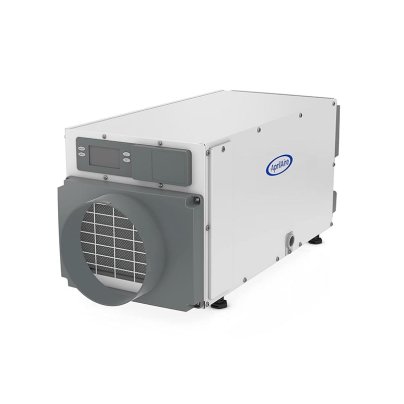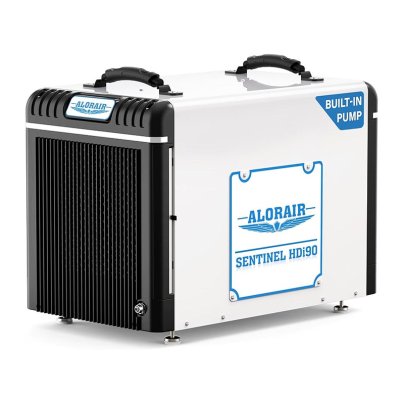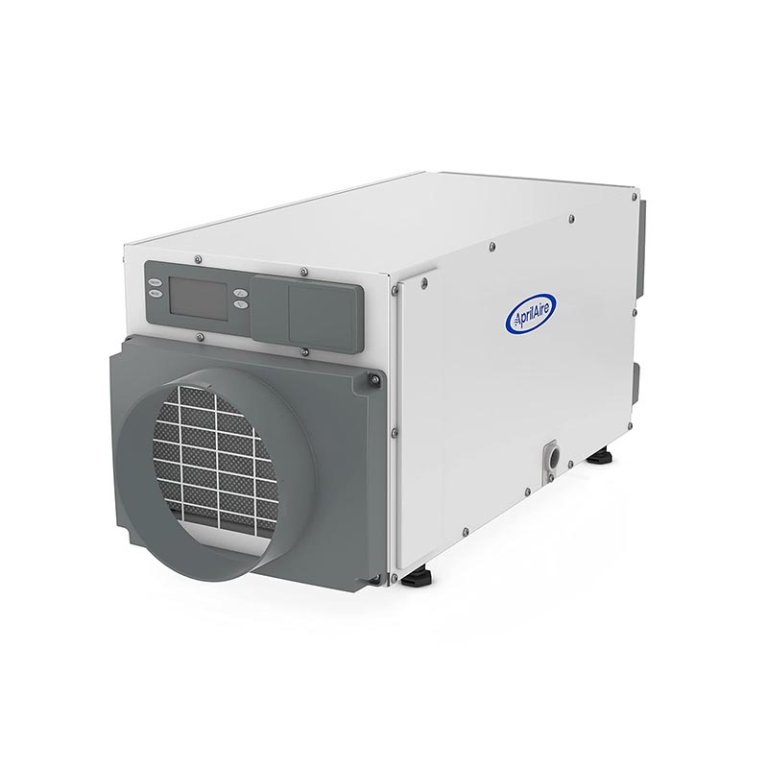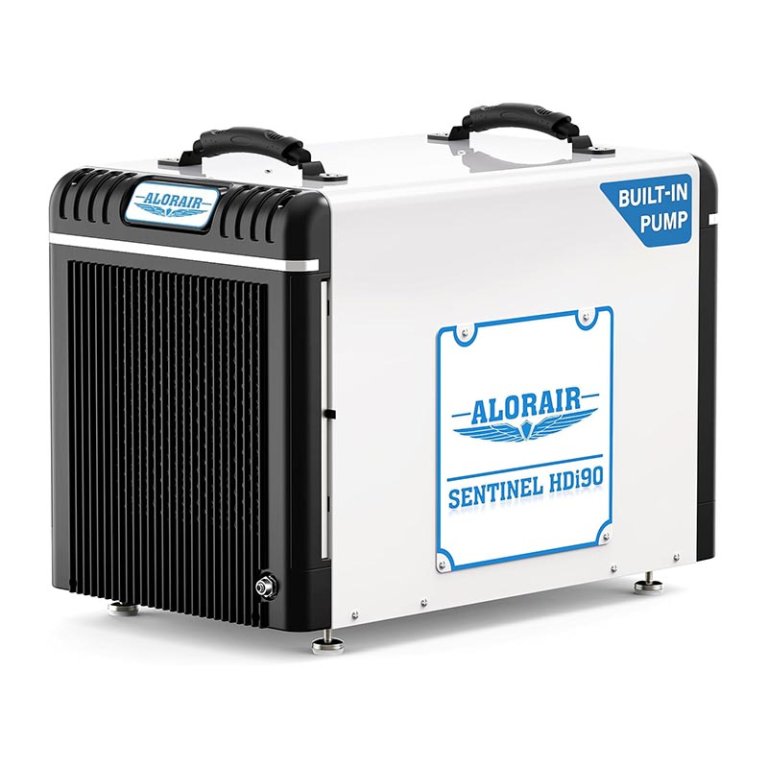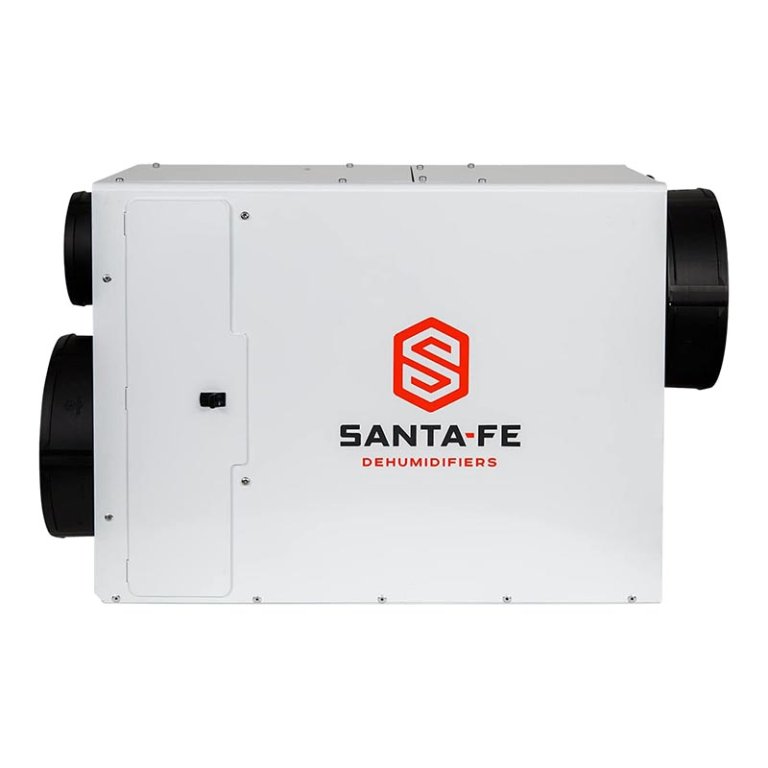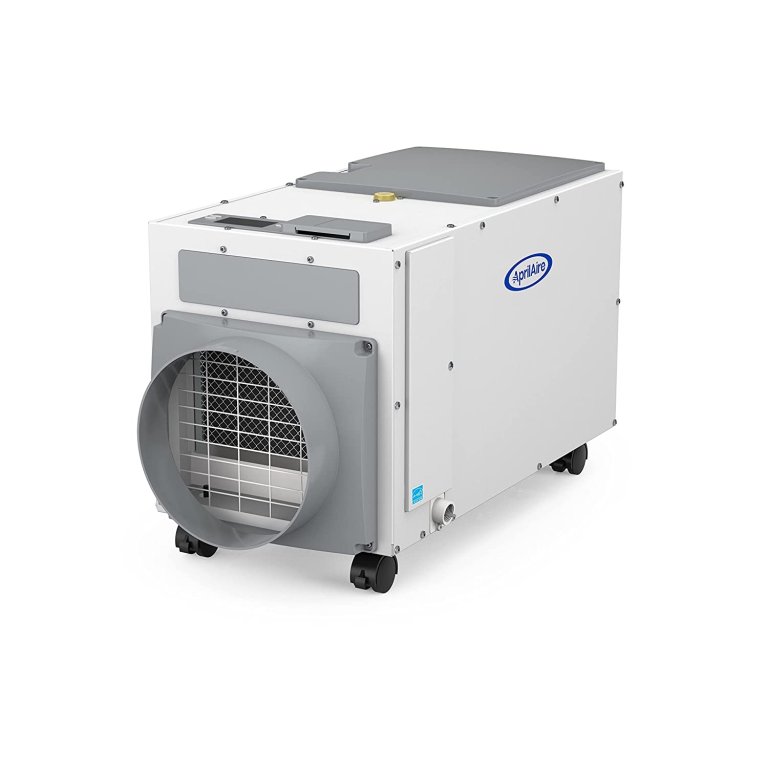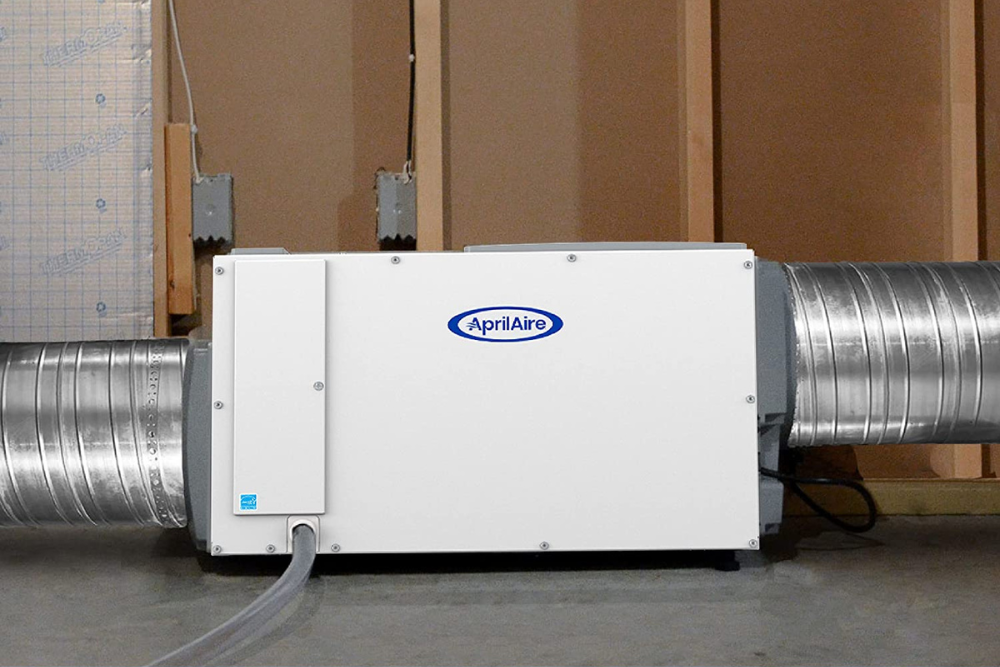
We may earn revenue from the products available on this page and participate in affiliate programs. Learn More ›
In humid regions, whole-house dehumidifiers improve indoor air quality and help the heating and cooling system operate more efficiently, and the lower humidity they provide makes it easier to heat and cool the home. By reducing moisture levels in the air, whole-house dehumidifiers make the home feel more comfortable while deterring pests and inhibiting mold growth. Unlike portable dehumidifiers, which can take up a lot of space when located in every room, a dehumidifier for whole-house air quality can be integrated with the home’s ductwork to improve air quality throughout every room in the house.
We spent a month testing five whole-house dehumidifiers, and the AprilAire E070 won best overall, largely due to its efficient performance and versatility. It can remove up to 70 pints of water from the air each day in homes up to 2,200 square feet, and it can be integrated with the home’s ductwork or installed independently. The other models in our lineup have plenty to offer, too. Some of them cover larger areas, pull more water from the air, and include premium features like remote monitoring and control, but they may require professional installation.
According to the U.S. Environmental Protection Agency, the optimal indoor humidity range is between 30 and 50 percent. Ahead, learn what to look for when shopping for a dehumidifier, and find out why the following models are among the best whole-house dehumidifiers for today’s shoppers.
- BEST OVERALL: AprilAire E070 Dehumidifier
↓ Jump to Review - BEST BANG FOR THE BUCK: AlorAir HDi90 Dehumidifier
↓ Jump to Review - BEST AIR QUALITY: Santa Fe Ultra98 Dehumidifier
↓ Jump to Review - BEST FOR LARGE HOMES: AprilAire E100C Dehumidifier
↓ Jump to Review - BEST FOR SMALL HOMES: Honeywell Ducted 65-Pint Dehumidifier
↓ Jump to Review
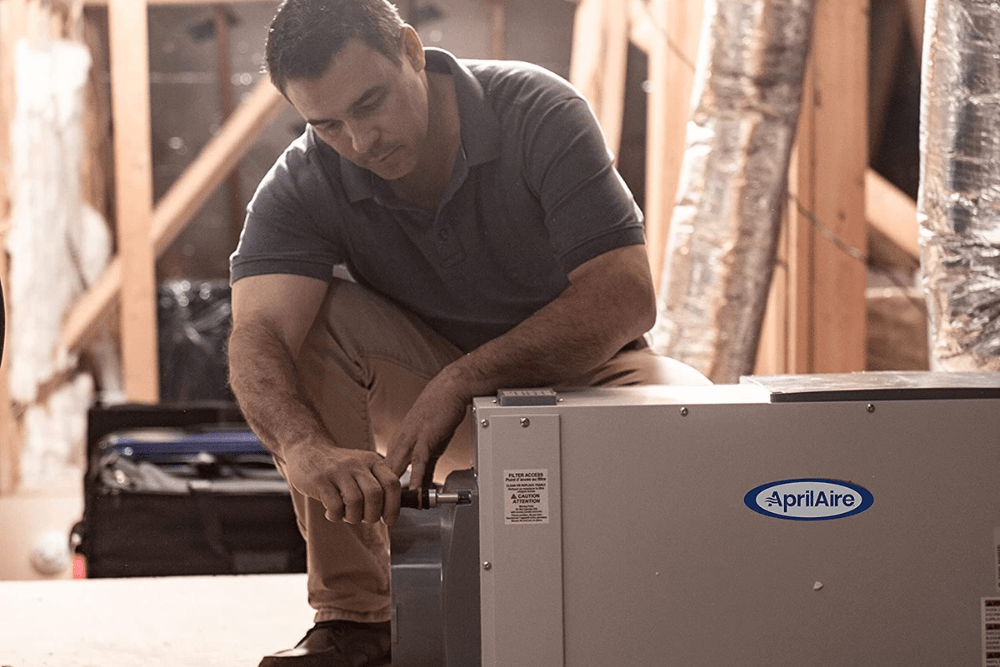
Whole House Dehumidifiers Comparison
| Product | Capacity | Coverage | Weight |
|---|---|---|---|
| AprilAire E070 Dehumidifier | 70 pints per day | 2,200 square feet | 56 pounds |
| AlorAir HDi90 Dehumidifier | 90 pints per day | 2,600 square feet | 70.5 pounds |
| Santa Fe Ultra98 Dehumidifier | 98 pints per day | 2,300 square feet | 81 pounds |
| AprilAire E100C Dehumidifier | 100 pints per day | 5,500 square feet | 64 pounds |
| Honeywell Ducted 65-Pint Dehumidifier | 65 pints per day | 1,800 square feet | 60 pounds |
Our Top Picks
For those looking to lower the level of humidity in their entire home, odds are that one of the whole-house dehumidifier systems in this lineup will fit the bill. In our tests, the following three models were easy to set up, quiet during operation, and effective. They vary in terms of price and the size of the living space they’re capable of effectively treating, but in the appropriate setting, each one will reduce moisture in the air and make the home’s occupants more comfortable.
Best Overall
Photo: AmazonWhat We Like
- Capable of removing a high volume of moisture
- Ample airflow for small and midsize homes
- Automatically maintains targeted humidity level
- Simple gravity drain system
What We Don’t Like
- Does not work with an elevated drain
- Larger and heavier than other options available
Specs
- Dehumidification capacity: 70 pints per day
- Coverage: 2,200 square feet
- Weight: 56 pounds
Our Ratings: Ease of Use 5/5; Noise 5/5; Effectiveness 5/5; Value 4/5
The AprilAire Pro 70-pint crawl space dehumidifier offers the best functionality for a crawl space or a whole home. This model features corrosion-resistant aluminum coils, a 200 CFM airflow, and automatic operation that adjusts according to moisture levels.
This large dehumidifier also features a gravity drain system that can be routed to a basement sump or other suitable drain. This unit does not require professional installation, and it may be installed independently or integrated with the home’s HVAC ductwork. It can run continuously without much maintenance and remove over 70 pints per day.
The simplicity of the E070 dehumidifier won us over. The large display and control panel on the intake end of the appliance set the stage for intuitive use. We also appreciated the refreshingly low-tech gravity drain (no pump to wear out), washable air filter, and corrosion-resistant aluminum condenser coils. During cool, damp weather, the risk of freeze damage is greatly reduced thanks to the automatic defrost system. Our overall impression was that this is an uncomplicated, durable, and affordable unit.
Our test went as well as we could have hoped. Following the easy setup instructions, we had it up and running within 15 minutes. By hour 12, it had reduced the humidity level by 12 percent to reach the target range, and it held steady for the remainder of the test. Although the E070 was not the most affordable unit we tested, it outpaced the group with easy setup, quiet operation, and efficient performance.
What our tester says: “The AprilAire dehumidifier was easy to set up as a standalone unit in the basement, but also offered the versatility to integrate with HVAC ductwork. I really liked how durable and uncomplicated it was, and it did a great job drying the air.”—Mark Wolfe, Product Reviews tester and writer
Get the AprilAire E070 whole-house dehumidifier at Amazon, The Home Depot, or Sylvane.
Best Bang for the Buck
Photo: AmazonWhat We Like
- Performance suitable for midsize homes
- Built-in condensate pump
- Auto-restarts if interrupted by a power outage
- Affordable price point
What We Don’t Like
- Remote control is sold separately
- Does not integrate with ductwork
Specs
- Dehumidification capacity: 90 pints per day
- Coverage: 2,600 square feet
- Weight: 70.5 pounds
Our Ratings: Ease of Use 4/5; Noise 4/5; Effectiveness 4.6/5; Value 4.5/5
If a damp basement or crawl space is the source of humidity and mold problems, the AlorAir Sentinel HDi90 is an affordable solution that doesn’t skimp on features. This model pulls up to 90 pints of water from the air each day in homes up to 2,600 square feet. It includes an auto-restart function to safeguard against power failures, a built-in condensate pump for easy water removal, and an auto-defrost function. A remote control is also available, sold separately.
The AlorAir HDi90 is remarkably powerful, but unlike other models we tested it is not designed for ductwork. We tested it in a damp basement (65 percent relative humidity) situated next to the HVAC unit. It lowered the humidity in the living space by 15 percent in less than 18 hours and maintained a relative humidity between 45 and 50 percent for the remainder of the test. From the basement floor, the powerful condensate pump had no trouble lifting the drain water to an elevated exit drain 9 feet above.
This large unit was more difficult to maneuver than some of the others we tested, which could make setting up in a cramped crawl space difficult. In our walkout basement, we had the luxury of a hand truck. The only thing that might have made the experience better was a remote control to monitor and control it from the main floor, but it’s sold separately.
Get the AlorAir whole-house dehumidifier at Amazon, Sylvane, or Mowers at Jacks.
Best Air Quality
Photo: AmazonWhat We Like
- Dehumidifier features a high-efficiency filter
- Can adapt to pull fresh outdoor air inside
- Well suited for use in midsize homes
- Quiet performance; operating volume comparable to a refrigerator
What We Don’t Like
- Professional installation is strongly recommended
- No built-in controller
Specs
- Dehumidification capacity: 98 pints per day
- Coverage: Up to 2,300 square feet
- Weight: 81 pounds
Our Ratings: Ease of Use 4/5; Noise 4.5/5; Effectiveness 5/5; Value 4/5
For midsize homes up to 2,300 square feet, the Santa Fe Ultra98 can deliver serious humidity reduction. It can remove as many as 98 pints of water in 24 hours when operating at full capacity, and water drains via a hose into a nearby drain—so there’s no tank to dump.
While all dehumidifiers have filters of some sort, the Santa Fe Ultra98 boasts a high-efficiency MERV 13 filter that can trap 90 percent or more of airborne particulates and dust mites that measure up to 3 microns in size. (For scale, an average human hair is about between 75 and 100 microns thick.) Not only does the Ultra98 remove unwanted humidity, it also banishes airborne pollutants.
The Ultra98 installs to the home’s HVAC ducting, and an optional outdoor air intake can be added to introduce fresh air to the home if desired. A separate controller is required for use with the Santa Fe Ultra98—the manufacturer suggests the Ultra-Aire DEH 3000/3000R (sold separately). Other controllers may be compatible, so check with an HVAC technician to be sure. Installing the Ultra98 quiet dehumidifier isn’t exactly easy, so professional installation is highly recommended.
Although setting up the Ultra98 was a more intensive process—it requires its own dedicated return duct to take in moist air, and distributes dry air through the HVAC’s supply plenum—it was worth the effort. This unit dropped the relative humidity in the living space faster than the other dehumidifiers thanks to a greater dehumidification capacity, stronger airflow, and direct circulation inside the living space. It did an outstanding job reaching and maintaining the target humidity level, and it did so very quietly.
The Santa Fe unit costs about twice as much as either of the two units we reviewed above. Add in the required control pad and professional installation, and you’re looking at a total cost above $3,000 in most cases. That’s a steep price for sure, but well worth it if humidity is a constant issue regardless of temperature.
What our tester says: “With strong airflow and drying capacity installed directly into the HVAC system, the Santa Fe dehumidifier made an immediate impact on indoor comfort. The drier air allowed us to raise the thermostat from 67 to 72 degrees while staying cool and comfortable.”—Mark Wolfe, Product Reviews tester and writer
Get the Santa Fe whole-house dehumidifier at Amazon, Sylvane, or HvacDirect.
More Great Options
If you have an extra-large or extra-small house, the whole-house dehumidifiers we tested might not be a good fit. Consider the following options, which we recommend based on their brand quality and features.
Best for Large Homes
Photo: AmazonWhat We Like
- Automatically turns on/off to maintain desired humidity
- Constructed from durable, corrosion-resistant materials
- Condensation is directed via a hose or pipe
What We Don’t Like
- Professional installation is recommended
- Requires separate condensate pump if no drain available
Specs
- Dehumidification capacity: 100 pints per day
- Coverage: Up to 5,500 square feet
- Weight: 64 pounds
The E100C Pro ducted dehumidifier from AprilAire made our lineup of whole-house dehumidifiers because of its quality, efficiency, and convenience. The E100C removes up to 100 pints of water from the air in a 24-hour period and is suitable for use in homes with up to 5,500 square feet of living space. The AprilAire E100 series has been tested and certified by Energy Star as being “most efficient,” meaning it’s among the best models for conserving energy while still providing high levels of indoor comfort and performance.
This dehumidifier installs on a home’s HVAC duct system, and professional installation is recommended. It features a single on/off switch, and the desired relative humidity (RH) level is programmed during installation, so there’s nothing for residents to adjust once installation is complete. Once set, the dehumidifier will sense and maintain the desired RH independently. Alternatively, a wired wall-mount controller (sold separately) can connect to adjust the dehumidifier from a central location.
This AprilAire dehumidifier comes with caster wheels that are designed to make it easier to roll the unit into place on a hard surface, such as a concrete basement floor. There’s no water tank to monitor or dump—optimally, condensation is routed through a pipe or tube into the same drain the HVAC uses. However, if the unit is located in a spot with no drain, such as a crawl space, a separate condensate pump will be necessary to remove the collected water to a suitable drain.
Get the AprilAire E100C whole-house dehumidifier at Amazon or SupplyHouse.com.
Best for Small Homes
Photo: AmazonWhat We Like
- Programmable; can also work with several Honeywell controllers
- No tank to empty; runs into floor drain
- Maintains optimal level of humidity without frequent adjusting
What We Don’t Like
- Professional installation is recommended
Specs
- Dehumidification capacity: 65 pints per day
- Coverage: Up to 1,800 square feet
- Weight: 60 pounds
From an industry leader in heating, cooling, and air purification comes our top pick for a whole-house dehumidifier for small houses. This Honeywell model dehumidifies living spaces up to 1,800 square feet and has a 65 pints-per-day removal rate.
Like the other ducted dehumidifiers in the lineup, the Honeywell installs on the home’s HVAC system. It features a built-in humidistat that can be programmed to the occupants’ desired level of humidity—the unit will then automatically turn on and off to maintain that level. Alternatively, this dehumidifier can be used in conjunction with several types of Honeywell digital controllers, such as the HumidiPRO Digital Controller (sold separately).
The Honeywell dehumidifier can be positioned over a floor drain or used with a hose to drain collected water to a nearby drain. If no drain is available, consider purchasing and installing a separate condensate pump to remove the collected water to a suitable drain.
Get the Honeywell whole-house dehumidifier at Amazon or Sylvane.
Jump to Our Top Picks
How We Chose and Tested the Best Whole-House Dehumidifiers
| Testing Stats | |
|---|---|
| Products tested | 5 |
| Time spent testing | 2 weeks |
| Tests performed | 6 |
| Price range | $600 to $2,500 |
We researched over 20 dehumidifiers for whole-house use, assessing quality, operating capacity, and cost-effectiveness. While we took brand reputation into account, particularly for industry leaders such as Santa Fe, AprilAire and Honeywell, we also explored newer brands that offered competitive pricing and strong buyer reviews. We brought in 5 models for testing based on their reputations for low noise, minimal maintenance, and impressive energy efficiency. To test them, we set them up in a basement with an average relative humidity of 65 to 70 percent and allowed each one to operate for 3 days. We used a digital temperature and humidity sensor to monitor conditions throughout the test. Finally, we recorded our observations on a scoring rubric to determine the winners and assign categories.
| Ease of Use | Noise | Effectiveness | Value | |
| AprilAire E070 Dehumidifier | 5 | 5 | 5 | 4 |
| AlorAir HDi90 Dehumidifier | 4 | 4 | 4.6 | 4.5 |
| Santa Fe Ultra98 Dehumidifier | 4 | 4.5 | 5 | 4 |
What to Consider When Choosing a Whole-House Dehumidifier
As a pricey investment, the best whole-house dehumidifiers shouldn’t be purchased on impulse. Below, learn about the factors and features to keep in mind while shopping for a unit. Different types of whole-house dehumidifiers have varying pros and cons, some relating to the type, while others relate to the initial investment or operating costs. Regardless of the type you choose, the benefits of a whole-house dehumidifier system are substantial.
Type
There are two main categories of dehumidifiers: portable and whole-house. Whole-house systems are usually (but not always) ducted, and connect to a home’s HVAC ducting. When the furnace or central air conditioning system is running, moist air from the house is pulled through the return air vents and then through the connected dehumidifier, where the moisture is removed. The dry air is then heated or cooled and dispersed throughout the house via vents. Some whole-house dehumidifiers are powerful enough to simply draw humidity from throughout the home. Portable generators are smaller and can be moved from room to room. These may have hoses to direct collected water to a drain or may include a tank to collect condensate that must be emptied.
In addition to the different types, there are two main methods of dehumidification: refrigerant and desiccant. In general (although there are exceptions), the desiccant method is used in portable dehumidifiers for rooms, and the refrigeration method is used in whole-house dehumidifiers.
- Refrigerant dehumidifiers work by pulling in hot, humid air and cycling it over a cold surface, usually coils filled with liquid refrigerant. When the hot air passes through the coils, it forms condensation and drips into the collection tank or out of the drainage tube into a floor drain. This is the preferred type of moisture removal found in a whole-house dehumidifier system.
- Desiccant dehumidifiers use chemicals that absorb moisture to pull water from the air as it cycles through the system. The water is collected in a tank or directed to a drain via a hose.
Dehumidification Capacity
Dehumidification capacity refers to the amount of moisture a dehumidifier can remove from the air on a daily basis. It is measured by the number of pints of water removed per day. The capacity can vary—even within the same model—depending on existing humidity, desired humidity level, size of the space, and temperature. Some manufacturers provide a capacity metric for their dehumidifiers. The Department of Energy provides guidelines and regulates the process of capacity testing for manufacturers seeking certification.
While single-room dehumidifiers typically remove between 25 and 40 pints of moisture daily, installed and ducted whole-house systems usually remove between 70 and 120 pints daily. It’s possible to use several room dehumidifiers and achieve the same dehumidification capacity as an installed whole-house dehumidifier. Going this route may make the most sense for renters, or those planning to move soon.
Coverage Area
Before purchasing a new whole-house dehumidifier, take stock of the size of the space they want to dehumidify. Matching the size of the space to the capacity and coverage area of the dehumidifier is known as “sizing.” Accurate sizing is critical to achieving maximum energy efficiency and dehumidification effectiveness.
While capacity and coverage are related, they are not synonymous. Just because a dehumidifier has a high pints per day (PPD) rating doesn’t mean it’s automatically well suited to a larger home. Things such as the size of the unit and the amount of air it circulates factor into the coverage area as well, so check both ratings when comparing dehumidifiers.
Keep in mind that there is no such thing as a portable whole-house dehumidifier, as these units are large and designed to install on the return-air ducting of the home’s HVAC system or be connected to a drain or pump. They are permanent fixtures.
Airflow
Many manufacturers list their dehumidifier’s airflow rate in cubic feet per minute (CFM), but if it doesn’t appear on the product’s listing, don’t be surprised—it’s not a requirement. Generally, whole-house dehumidifiers come with ratings of 100 to 300 CFM, with the larger and more powerful models typically located at the upper end of the range.
This is where the advice of an HVAC professional can be particularly helpful, as the goal is to ensure sufficient airflow to process the air in the home quickly and efficiently. On the other hand, if the airflow exceeds what is needed, the unit can remove excess moisture, resulting in dry, itchy skin and higher-than-necessary utility bills from operating an oversize unit.
Keep in mind that units with high airflow ratings may be noisier than those with lower ratings, so the goal is to balance coverage, capacity, and airflow.
Energy Efficiency
To be sure you’re choosing an energy-efficient dehumidifier, we recommend choosing one with Energy Star certification. Another thing to keep in mind is the size of the unit. Something that’s too large for the space in question will cause energy waste, while something too small will cause the system to overwork itself, which lessens its longevity.
Some dehumidifiers come with smart sensors. Place the sensors in different areas of the home, and the dehumidifier will run only as needed to maintain the desired humidity level in those areas. In terms of long-term efficiency, modern, fully-installed ducted dehumidifiers are more energy efficient than portable room dehumidifiers, but they come with higher upfront costs.
Drainage
Portable units come with internal collection tanks, whereas whole-house dehumidifiers do not. Still, all dehumidifiers remove water from the air, and that water has to have a place to go. Whole-house dehumidifiers are designed with drainage ports, which can be used in two ways. The user can position the drain port directly over a floor drain, which is standard practice, or attach a drain hose and drop the end of the hose in a nearby floor drain.
That works well if the dehumidifier is installed in a basement or utility room next to the HVAC unit, because the HVAC unit also produces condensed water that requires a drain. It doesn’t work as well when there’s no space to locate the dehumidifier next to the HVAC unit.
When that happens, the dehumidifier is often located in an adjacent room or below the HVAC unit in a crawl space, and there may be no drain nearby. In those cases, the user will want to install a separate condensate pump and run a drain hose from the dehumidifier to the pump, which then pumps the water to a remote drain or to the yard’s surface, where it can run off.
Additional Features
Helpful extras such as digital displays, remote controllability, Wi-Fi connectivity, and internal filter-change warning systems make a dehumidifier easier to use. Wi-Fi connectivity or app control is a nice feature, as it allows users to monitor the unit as it operates and adjust the desired humidity level up or down as needed. A few whole-house dehumidifiers offer added features, such as high-efficiency filters that remove airborne particles while also reducing humidity. Others may offer the option of attaching a fresh-air intake hose that brings outdoor air inside to help reduce stuffiness.
FAQs
Purchasing a good dehumidifier can be quite an investment, and shoppers might have some additional queries. Check out the most commonly asked questions and their answers below to help make the decision.
Whole-house dehumidifiers protect a home from damage caused by mold and mildew, which is definitely worth it in the long run. A whole-house dehumidifier is also more cost-effective and energy efficient than replacing an entire HVAC system.
These units draw in humid indoor air, use a refrigerant-based system to condense excess moisture, drain away the water, and then expel drier air into the home via the home’s vent system.
If a whole-house dehumidifier is designed for continuous operation, it can be run for 24 hours a day. Many models even come with automatic operation, which maintains preset humidity levels in a home hands-free.
Dehumidifiers for household use should not be used in temperatures lower than 60 degrees Fahrenheit, since any cold moisture can freeze the coils and cause malfunctions or irreversible damage.
Like most whole-house appliances, dehumidifiers can be energy-intensive. Still, the ultimate cost depends on the PPD rating, the unit’s wattage, and the local cost of electricity. Those trying to get a good idea of the energy usage of a dehumidifier can use an online calculator to help predict the monthly fee. And keep an eye out for a dehumidifier with Energy Star certifications, which can reduce energy costs.
Moisture levels and humidity differ based on climate. When deciding what size dehumidifier is needed, remember that a 30- to 40-pint capacity should cover 500 to 1,500 square feet, while a 40- to 70-pint whole-home dehumidifier can handle spaces of up to 4,500 square feet.
The best spot is close to the existing HVAC system because most whole-house dehumidifiers must be tied into the ducting. In many homes, this means in a utility room or a basement. If there’s not enough available space right next to the HVAC system, a professional will install the dehumidifier nearby, sometimes in a crawl space, and run the ducting through the walls or floor to reach the HVAC system.
A whole-house dehumidifier installation usually costs between $1,300 and $2,800, including the price of the dehumidifier. Extra-large or powerful units can run higher.
Whole-house dehumidifiers with quality constructions can last for 8 to 15 years if used correctly.
Meet the Tester
Mark Wolfe is a writer, product tester and serial DIYer. When he isn’t writing, he spends his time upgrading, repairing, and replacing anything and everything in his home, yard, and garden. He tests and writes reviews about hand and power tools, lawn care and home repair products, and outdoor living goods.
Additional research provided by Will Briskin and Glenda Taylor
